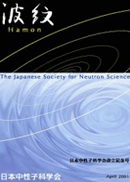
- 4 号 p. 174-
- 3 号 p. 118-
- 2 号 p. 64-
- 1 号 p. 2-
- |<
- <
- 1
- >
- >|
-
野尻 浩之2018 年 28 巻 3 号 p. 118-122
発行日: 2018/08/10
公開日: 2019/11/15
ジャーナル フリーRecent advances in neutron diffraction experiments in pulsed magnetic fields are introduced. The basic concept of a pulsed magnetic field is explained and the comparison of instruments at different facilities is summarized. Two examples of neutron diffractions on URu2Si2 and LiNiPO4 are presented. The recent status of the 26 T hybrid magnet at Berlin neutron center is reported. An example of the diffraction in pulsed magnetic fields with the X-ray free electron laser is briefly introduced and the feature is compared with that of synchrotron source.
抄録全体を表示PDF形式でダウンロード (851K) -
間宮 広明2018 年 28 巻 3 号 p. 123-126
発行日: 2018/08/10
公開日: 2019/11/15
ジャーナル フリーPotential of neutron transmission spectroscopy is reviewed from the viewpoints of research and development in magnetism and magnetics. The observation of magnetic Bragg dips requires only the detection of neutron transmitted through a sample along linear narrow path, hence, it has a high affinity for extreme condition-generating devices. This feature is helpful in advancing the frontier in magnetism. On the other hand, the observation of magnetic Bragg edges is useful for measurements of spin arrangements using compact neutron sources because converging optical systems can be utilized without limitation. The resulting opportunities promote to expand the base of magnetism. Furthermore, rectilinearity of the transmitted neutron enables us simultaneous measurements for a plurality of samples that aids high throughput optimization of magnetic materials as well as Bragg edge imaging for magnetic devices. Thus, the neutron transmission spectroscopy is a promising tool in various research field from basic research to practical application of magnetic materials.
抄録全体を表示PDF形式でダウンロード (574K) -
松田 雅昌2018 年 28 巻 3 号 p. 127-130
発行日: 2018/08/10
公開日: 2019/11/15
ジャーナル フリーMnP exhibits superconductivity under pressure with a maximum transition temperature of ~1 K at 8 GPa. Since Mn has the spin degree of freedom, elucidating the magnetic contribution to the superconductivity is crucial to understand the pairing mechanism. We performed neutron diffraction experiments in MnP under high pressure and determined the magnetic phase diagram as a function of pressure. We found that a helical magnetic structure is in the vicinity of the superconducting phase, which is similar to the magnetic structure in the sister material CrAs. In this study, challenging high-pressure neutron diffraction measurements were performed. The high-pressure techniques, including the recent development, are also shown in this article.
抄録全体を表示PDF形式でダウンロード (717K)
-
西木 直巳2018 年 28 巻 3 号 p. 131-134
発行日: 2018/08/10
公開日: 2019/11/15
ジャーナル フリーI introduce graphite used as neutron monochromator and filter. There are gas phase method and solid phase method for making graphite. Panasonic Corporation has been working on solid phase method. Here, the comparison between the vapor phase method and the solid phase method, and the subsequent development will also be explained. Graphite block made by the solid phase method is used in JRR-3 etc.
抄録全体を表示PDF形式でダウンロード (961K)
-
勅使河原 誠2018 年 28 巻 3 号 p. 135-143
発行日: 2018/08/10
公開日: 2019/11/15
ジャーナル フリーFrom “How to Produce Neutrons” point of view, the design of moderator used for pulsed neutron source is described for neutron scattering experiments. The pulse characteristics of high peak intensity, narrow pulse width and short tail, are three essential elements for short-pulsed neutron beam, which is produced by slowing down process of fast neutrons in a moderator. The high peak intensity and the narrow width are in a relationship of trade-off. We developed three kinds of moderators, which dedicated to peak intensity or narrow width or short tail, for MW class short-pulsed neutron source. Each neutronic performance of moderator is described.
抄録全体を表示PDF形式でダウンロード (5824K) -
平賀 晴弘, 山口 泰男, 丸山 龍治, 奥 隆之, 猪野 隆2018 年 28 巻 3 号 p. 144-149
発行日: 2018/08/10
公開日: 2019/11/15
ジャーナル フリーPolarized neutrons have enormous scientific and technological potential in fundamental physics, solid state physics, materials science, biology, engineering applications, etc. Polarized neutrons are most commonly used to investigate magnetic properties of materials, but they can also be utilized for studies of soft matter, biology, and life science. Imaging of magnetic fields can be possible with polarized neutrons. Fundamental symmetries of the universe can be explored as well. Not to forget the spin echo. Some of the techniques to produce spin-polarized neutrons, namely polarizing crystals, polarizing supermirrors, and neutron spin filters, are briefly described.
抄録全体を表示PDF形式でダウンロード (942K)
- |<
- <
- 1
- >
- >|